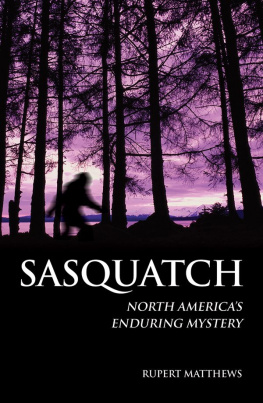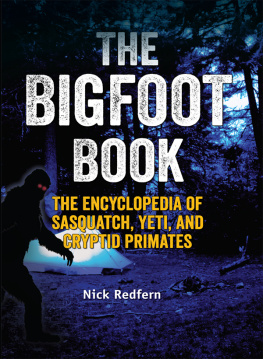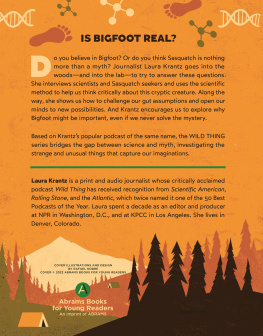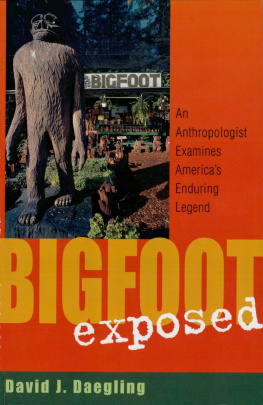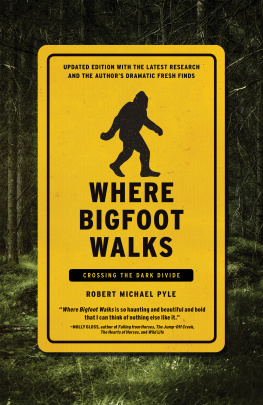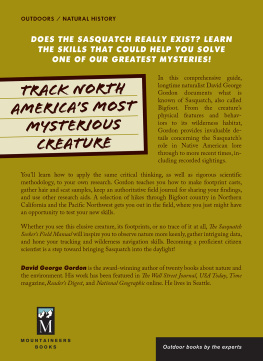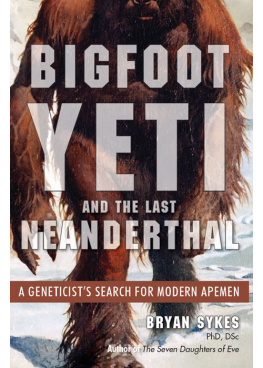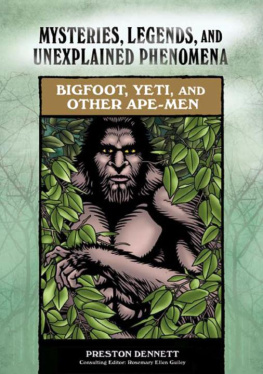All rights reserved. No part of this publication may be reproduced, stored in a retrieval system, or transmitted, in any form or by any means, electronic, mechanical, photocopying, recording or otherwise, without prior written permission in accordance with the provisions of the Copyright Act 1956 (as amended). Any person or persons who do any unauthorised act in relation to this publication may be liable to criminal prosecution and civil claims for damages.
INTRODUCTION
S asquatch or Bigfoot is an enigma that has captured the imagination of generations of North Americans, especially those who take pleasure in the great outdoors and an interest in the folklore of rural communities where this legendary creature is accepted as an ever-present. Encounters with Sasquatch have been reported across North America. Such reports are not scarce there have been thousands over the years. A comparison of these reports quickly turns up striking similarities. Witnesses describe blood-curdling screams, a pungent odour that defies description, and the hurling of rocks. In appearance Sasquatch resembles a gigantic, upright hominid ape.
Creatures similar to Sasquatch have also been seen wandering the jungles of South America, although they appear to be smaller and less human-like than those of the north. However, it is not just in the Americas that these apes are to be found. The high Himalayas are home to the enigmatic Yeti, the Sumatran jungles harbour a short hairy man called the Orang Pendek and Central Asia is stalked by a being that might be a primitive form of human, which locals call the Almas. Over the border in China, reports are made of an almost identical beast called the Yeren while even Australia gets in on the act with a big hairy ape called the Yowie.
What all of these animals, or perhaps humans, have in common is that conventional science does not recognize their existence, so they are classed as cryptids or hidden ones. That is, sightings have been reported but there is not enough evidence to satisfy the scientific community. The standard of evidence needed is high. Each of these creatures will be seen as a cryptid until an example living or dead is produced for examination. However, if a suitable example, or type specimen to use the scientific term, were produced the beast would be accepted as a known animal.
And yet there is ample proof that some, at least, of these cryptids are real animals. The existence of the Sasquatch is supported by an impressive mass of evidence and the quality of some of it is very convincing. However, it must be admitted that the remaining evidence can be of poor quality; in some instances it has even been falsified by hoaxers. A smaller amount of evidence points to the existence of the other man-beast cryptids, but what there is can be extremely persuasive. Even so, most scientists refuse to accept the reality of these beasts.
The purpose of this book is to study and review the evidence for the existence of these cryptid man-like or ape-like creatures. But before launching into the hunt for the unknown, it is as well to deal with a few general points and principles.
First, it is important to be clear that a great many cryptids have been accepted as known animals by the scientific world. Among these have been the gorilla and the okapi, both of which were the subject of wild tales among the tribesmen of Africa. These tales were widely discounted by European scientists and the creatures were written off as fabulous. But when a type specimen was produced, the scientific world rapidly accepted the reality of the beasts and set off to investigate them thoroughly.
Those days are not yet over cryptids are still sneaking into reality. Around 20 new species of mammal alone have been accepted by science every year since the mid-1990s. Most of these beasts are fairly small and are simply new species of already accepted types of animal. But not all of them.
People living in the Vietnamese forests have for years been telling Europeans about a large antelope-like creature that is very rare, very shy and lives in the dense mountain forests of the Nghe An and Ha Tinh provinces. Nobody took the tales seriously until 1992, when a zoologist was handed a pair of horns that he could not identify. Such hard evidence demanded further investigation so an expedition was organized and sent into the mountains. Within a very short time the members of the party had been shown one of the mystery creatures by local huntsmen. The saola has been accepted as a known animal ever since. There are thought to be only a few hundred of them browsing on leaves in the forests but whether the animal is part of the bovine species or is a type of antelope or goat remains unclear.
The fact that such a large mammal could live unknown to science came as something of a surprise to many people. It indicates that it is possible for large animals to hide from science with surprising ease, given the right conditions.
Many people who are engaged in the hunt for cryptids they are generally known as cryptozoologists can feel resentment towards the scientific establishment as a whole and some individual scientists in particular. There is a feeling that scientists have deliberately closed their minds to the possible existence of cryptid hominoids. Any evidence put forward is dismissed as mistaken, or a hoax, sometimes after no more than a cursory examination. Some scientists seem determined to prove that such cryptids do not exist, to the extent that several have been accused of wilfully misinterpreting data to back up their stance.
In some instances such criticism is no doubt justified, but to be fair to scientists as a whole it must be acknowledged that they often work under constraints. The scientists working in areas most closely related to cryptid hominoids are zoologists studying primates. They might spend much of their time teaching students and marking papers and any time that they devote to research must be funded by universities or public bodies of one kind or another. Research funding is much in demand. It is generally only awarded to projects that are put forward by scientists who are already experienced in the field and so have a reasonable chance of producing a significant result. It also helps if the research project includes something that is currently fashionable in the academic world a prime example being climate change in the years after 2005.
Sasquatch, Yetis and the like simply do not fit into this pattern. The study of these creatures is not supported by a mass of pre-existing data, it does not offer a good chance of a significant result and it is not promoted by scientists already highly experienced in the field of cryptid hominoids because there arent any. Above all, this field is not fashionable in the way that climate change is so the chances of any scientist getting research backing are practically nil. Some scientists who have chosen to devote some of their time to cryptids have been instructed by their employers to drop the subject and spend their time studying something more likely to produce a positive result. Scientists are only human in that they often have families to support and so, understandably, do not want to fall foul of their employers.
That said a growing number of scientists are willing to devote much of their spare time to looking into cryptid hominoids. Because they are prepared to analyse evidence collected by field researchers, who are inevitably not professional scientists, they have produced a body of evidence that something is living out there. At the same time, they have also successfully identified hoaxes and misidentification.

